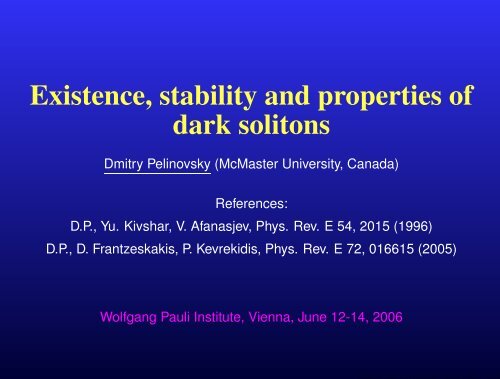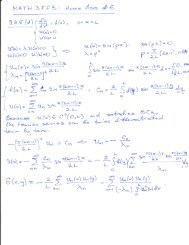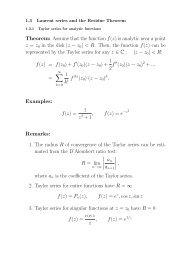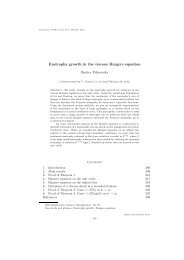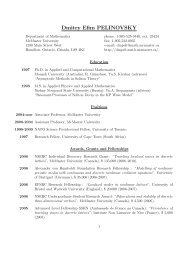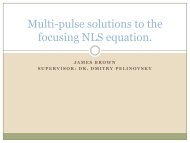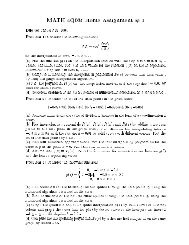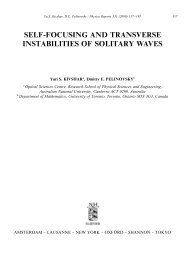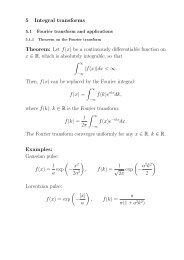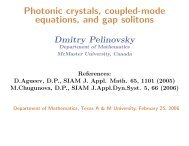Existence, stability and properties of dark solitons - Dmitry ...
Existence, stability and properties of dark solitons - Dmitry ...
Existence, stability and properties of dark solitons - Dmitry ...
Create successful ePaper yourself
Turn your PDF publications into a flip-book with our unique Google optimized e-Paper software.
<strong>Existence</strong>, <strong>stability</strong> <strong>and</strong> <strong>properties</strong> <strong>of</strong><br />
<strong>dark</strong> <strong>solitons</strong><br />
<strong>Dmitry</strong> Pelinovsky (McMaster University, Canada)<br />
References:<br />
D.P., Yu. Kivshar, V. Afanasjev, Phys. Rev. E 54, 2015 (1996)<br />
D.P., D. Frantzeskakis, P. Kevrekidis, Phys. Rev. E 72, 016615 (2005)<br />
Wolfgang Pauli Institute, Vienna, June 12-14, 2006
Definitions <strong>of</strong> <strong>dark</strong> <strong>solitons</strong><br />
Question: What are <strong>dark</strong> <strong>solitons</strong>?
Definitions <strong>of</strong> <strong>dark</strong> <strong>solitons</strong><br />
Question: What are <strong>dark</strong> <strong>solitons</strong>?<br />
Answers:<br />
• Physicists: Waves in defocusing systems with modulationally<br />
stable continuous wave (CW) background<br />
• PDE analysts: Localized solutions <strong>of</strong> PDEs with non-zero<br />
boundary conditions <strong>and</strong> non-zero phase shift<br />
• Applied mathematicians: A family <strong>of</strong> traveling waves from<br />
KdV <strong>solitons</strong> (grey <strong>solitons</strong>) to kinks (black <strong>solitons</strong>)
Reasons to dislike <strong>dark</strong> <strong>solitons</strong><br />
Physicists do not like <strong>dark</strong> <strong>solitons</strong> as<br />
• <strong>dark</strong> <strong>solitons</strong> have infinite energy due to a background<br />
• it is difficult to distinguish experimentally between the soliton<br />
<strong>and</strong> the background<br />
• <strong>dark</strong> <strong>solitons</strong> have no direct engineering applications
Reasons to dislike <strong>dark</strong> <strong>solitons</strong><br />
Physicists do not like <strong>dark</strong> <strong>solitons</strong> as<br />
• <strong>dark</strong> <strong>solitons</strong> have infinite energy due to a background<br />
• it is difficult to distinguish experimentally between the soliton<br />
<strong>and</strong> the background<br />
• <strong>dark</strong> <strong>solitons</strong> have no direct engineering applications<br />
Mathematicians do not like <strong>dark</strong> <strong>solitons</strong> as<br />
• tricky renormalization <strong>of</strong> all integral quantities is required<br />
• two-wave radiation is similar to Boussinesq systems<br />
• all results are formal so far <strong>and</strong> even formal results are too<br />
cumbersome in details
Main model for <strong>dark</strong> <strong>solitons</strong><br />
Defocusing one-dimensional NLS equation<br />
iu t = − 1 2 u xx + f(|u| 2 )u,<br />
where f(s) is C ∞ with f ′ (s) > 0 for some 0 ≤ s ≤ s 0 .
Main model for <strong>dark</strong> <strong>solitons</strong><br />
Defocusing one-dimensional NLS equation<br />
iu t = − 1 2 u xx + f(|u| 2 )u,<br />
where f(s) is C ∞ with f ′ (s) > 0 for some 0 ≤ s ≤ s 0 .<br />
Examples:<br />
• f = |u| 2 (integrable by inverse scattering)<br />
• f = |u| 2 ± |u| 4 (cubic-quintic)<br />
• f = −1/(1 + |u| 2 ) (saturable)
Conserved quantities<br />
• Hamiltonian [u(x, t) ↦→ u(x, t − t 0 )]<br />
H = 1 ∫ (<br />
|u x | 2 + 2<br />
2<br />
R<br />
∫ |u|<br />
2<br />
0<br />
f(s)ds<br />
)<br />
dx<br />
• Power [u ↦→ ue iθ 0<br />
] momentum [u(x, t) ↦→ u(x − x 0 , t)]<br />
N =<br />
∫<br />
|u| 2 dx, P = i ∫<br />
2<br />
R<br />
R<br />
(ūu x − ū x u) dx<br />
• Phase shift<br />
S = [arg(u)] x→+∞<br />
x→−∞ = i 2<br />
∫<br />
R<br />
(ūx<br />
ū − u x<br />
u<br />
)<br />
dx
ODE analysis <strong>of</strong> existence<br />
Traveling stationary solutions<br />
u(x, t) = U(x − vt)e iωt ,<br />
where (v, ω) are parameters <strong>and</strong> U(z), z = x − vt satisfies:<br />
− 1 2 U ′′ (z) + ωU(z) + ivU ′ (z) + f(|U| 2 )U = 0<br />
Separation <strong>of</strong> variables U(z) = Φ(z)e iΘ(z) leads to<br />
d<br />
dz<br />
[<br />
Φ 2 (Θ ′ − v) ] = 0 ⇒ Θ ′ (z) = v − c<br />
Φ 2 (z) ,<br />
where c is constant <strong>of</strong> integration.
Parameters <strong>of</strong> <strong>dark</strong> <strong>solitons</strong><br />
Recall the Galilei transformation<br />
u(x, t) ↦→ u(x − kt, t)e ik(x−kt/2) .<br />
The constant c can be chosen from the boundary conditions:<br />
lim Φ(z) = √ q,<br />
z→±∞<br />
lim Θ(z) = Θ ±,<br />
z→±∞<br />
subject to the sufficient decay <strong>of</strong> Φ(z) <strong>and</strong> Θ(z) to constant values.<br />
Then,<br />
c = vq, S = Θ + − Θ − .
Reduction to the second-order ODE<br />
After Θ ′ (z) is eliminated from the system, we obtain:<br />
Φ ′′ − 2(ω + f(Φ 2 ))Φ + v 2 Φ4 − q 2<br />
Φ 3 = 0<br />
From existence <strong>of</strong> the equilibrium state Φ = √ q:<br />
ω = −f(q)<br />
From the condition that Φ = √ q is a hyperbolic point:<br />
v 2 < qf ′ (q) ≡ c 2 ,<br />
such that the family <strong>of</strong> <strong>dark</strong> <strong>solitons</strong> exist for −c < v < c.
Example<br />
Cubic NLS with f(|u| 2 ) = |u| 2 :<br />
U(z) = Φ(z)e iΘ(z) = k tanh(kz) + iv,<br />
where k = √ q − v 2 <strong>and</strong> v 2 < q.<br />
• When v → √ q, the <strong>dark</strong> soliton approaches the KdV soliton<br />
Φ(z) = √ q −<br />
k2<br />
2 √ q sech2 (kz) + O(k 4 ).<br />
• When v → 0, the <strong>dark</strong> soliton approaches the kink<br />
U(z) = √ q tanh(qz)
Black soliton<br />
Black soliton corresponds to v = 0, when<br />
where U(z) satisfies:<br />
or<br />
1<br />
2 (U ′ ) 2 + 2<br />
Two solutions exist:<br />
U(z) = Φ(z)e iΘ(z) ∈ R,<br />
U ′′ + 2(f(q) − f(U 2 ))U = 0<br />
∫ U<br />
2<br />
q<br />
(f(q) − f(s))ds = const = 0<br />
• Kink Φ(−z) = −Φ(z) <strong>and</strong> Φ(0) = 0 [S = π]<br />
• Soliton on background Φ(−z) = Φ(z) <strong>and</strong> Φ(0) > 0 [S = 0]
Variational principle for <strong>dark</strong> <strong>solitons</strong><br />
The same ODE for U(z) is obtained from the first variation <strong>of</strong><br />
Λ = H(U) + vP (U) + ωN(U) + CS(U),<br />
where C is arbitrary <strong>and</strong> S(U) is a Casimir functional. We have<br />
seen that ω = −f(q) <strong>and</strong> v is a free parameter.
Variational principle for <strong>dark</strong> <strong>solitons</strong><br />
The same ODE for U(z) is obtained from the first variation <strong>of</strong><br />
Λ = H(U) + vP (U) + ωN(U) + CS(U),<br />
where C is arbitrary <strong>and</strong> S(U) is a Casimir functional. We have<br />
seen that ω = −f(q) <strong>and</strong> v is a free parameter.<br />
Let<br />
U = Φe iΘ ,<br />
Θ ′ = v<br />
(1 − q )<br />
.<br />
Φ 2<br />
Then, the second-order ODE for Φ(z) is obtained from the first<br />
variation <strong>of</strong> Λ in Φ only if C = vq.
Miracle <strong>of</strong> renormalization<br />
New variational principle for <strong>dark</strong> <strong>solitons</strong>:<br />
Λ = H r (U) + vP r (U) : H ′ r(U) + vP ′ r(U) = 0,<br />
where<br />
H r = 1 2<br />
∫<br />
R<br />
(<br />
|u x | 2 + 2<br />
∫ |u|<br />
2<br />
q<br />
(f(s) − f(q))ds<br />
)<br />
dx<br />
<strong>and</strong><br />
P r = i 2<br />
∫<br />
R<br />
(ūu x − ū x u)<br />
(<br />
1 − q<br />
|u| 2 )<br />
dx
Miracle <strong>of</strong> renormalization<br />
New variational principle for <strong>dark</strong> <strong>solitons</strong>:<br />
Λ = H r (U) + vP r (U) : H ′ r(U) + vP ′ r(U) = 0,<br />
where<br />
H r = 1 2<br />
∫<br />
R<br />
(<br />
|u x | 2 + 2<br />
∫ |u|<br />
2<br />
q<br />
(f(s) − f(q))ds<br />
)<br />
dx<br />
<strong>and</strong><br />
P r = i 2<br />
∫<br />
R<br />
(ūu x − ū x u)<br />
(<br />
1 − q<br />
|u| 2 )<br />
dx<br />
Alternative picture on renormalization in<br />
Yu. Kivshar <strong>and</strong> X. Yang, Phys. Rev. E 49, 1657 (1994)
Renormalized momentum<br />
By construction,<br />
P r (v) = −v<br />
∫<br />
R<br />
Φ 2 (1 − q Φ 2 ) 2<br />
dx = −vN(v) + qS(v).<br />
Two solutions as v → 0:<br />
• Kink with lim<br />
v→0<br />
P r (v) = πq<br />
• Soliton on background with lim<br />
v→0<br />
P r (v) = 0
Stability <strong>of</strong> black <strong>solitons</strong><br />
Linearization at the black soliton U(z)e −if(q)t with v = 0:<br />
[<br />
]<br />
u = e −if(q)t U(z) + (u(z) + iw(z))e λt + (ū(z) + i ¯w(z))e¯λt<br />
Spectral <strong>stability</strong> problem:<br />
L + u = −λw,<br />
L − w = λu,<br />
where<br />
L + = − 1 2 ∂2 x + f(U 2 ) − f(q) + 2Φ 2 f ′ (Φ 2 ),<br />
L − = − 1 2 ∂2 x + f(U 2 ) − f(q).
Spectra <strong>of</strong> L ± in L 2 (R)<br />
Continuous spectra σ c :<br />
• σ c (L + ) ≥ 2c 2 > 0<br />
• σ c (L − ) ≥ 0, with L − U(z) = 0<br />
Kernel <strong>and</strong> negative eigenvalues in L 2 (R):<br />
• Kink with S = π:<br />
• L + U ′ (z) = 0 <strong>and</strong> L + has no negative eigenvalues<br />
• L − has exactly one negative eigenvalue <strong>and</strong> no kernel<br />
• Soliton on background with S = 0:<br />
• L + U ′ (z) = 0 <strong>and</strong> L + has exactly one negative eigenvalue<br />
• L − has no negative eigenvalues <strong>and</strong> no kernel.
Constrained L 2 -space<br />
Consider for |λ| ≥ ɛ > 0:<br />
L + u = −λw,<br />
L − w = λu,<br />
If w ∈ L 2 (R), then w(z) must be orthogonal to ker(L + ) = {U ′ (z)}.<br />
Define the constrained space<br />
X c = { w ∈ L 2 (R) : (U ′ , w) = 0 }<br />
For λ ≠ 0, the <strong>stability</strong> problem is equivalent to the generalized<br />
eigenvalue problem in X c :<br />
L − w = γL −1<br />
+ w, γ = −λ 2
Analysis for kinks only<br />
Theorem: Operator L − has no negative eigenvalues in X c if<br />
P ′ r(v)| v=0 > 0 <strong>and</strong> exactly one negative eigenvalue if P ′ r(v)| v=0 < 0.<br />
A delicate detail in the pro<strong>of</strong>: The inhomogeneous equation<br />
have two solutions:<br />
L − w = U ′ (z)<br />
• w = −zU(z) - linearly growing in z<br />
• w = ∂ v U(z)| v→0 - bounded but non-decaying in z<br />
If the second (bounded) solution is selected, then<br />
(U ′ , L −1<br />
− U ′ ) = (U ′ , ∂ v U| v→0 ) = P ′ r(v)| v→0<br />
<strong>and</strong> the statement follows by the variational theory in X c .
Application <strong>of</strong> Pontryagin Theorem<br />
Theorem: Eigenvalues <strong>of</strong> the problem L + L − w = −λ 2 w in X c<br />
satisfy:<br />
N unst (L + L − ) + N negKrein (L + L − ) = N neg (L + ) + N neg (L − )<br />
Then,<br />
• Kink with S = π: stable for P ′ r(0) > 0 <strong>and</strong> unstable with one<br />
real positive eigenvalue for P ′ r(0) < 0<br />
• Soliton on background with S = 0: always unstable<br />
"Pioneer" results:<br />
• I. Barashenkov, Phys. Rev. Lett. 77, 1193-1197 (1996)<br />
• D.P., Yu. Kivshar, Phys. Rev. E 54, 2015-2032 (1996)<br />
• Y. Chen, M. Mitchell (1996) - unpublished
Stability <strong>of</strong> <strong>dark</strong> <strong>solitons</strong><br />
Stability analysis <strong>of</strong> black <strong>solitons</strong> can be extended for the complete<br />
family <strong>of</strong> <strong>dark</strong> <strong>solitons</strong> in constrained space associated to P r[u] ′ = 0,<br />
where<br />
P r [u] = i ∫<br />
(<br />
(ūu x − ū x u) 1 − q )<br />
dx<br />
2<br />
|u| 2<br />
<strong>and</strong><br />
R<br />
P ′ r[U] = −i(U ′ , u) + i(Ū ′ , ū) = 0.<br />
Dark <strong>solitons</strong> are stable when P ′ r(v) > 0 <strong>and</strong> unstable when<br />
P ′ r(v) < 0 at the solution family P r (v) = P r [U].
Example<br />
Cubic-quintic NLS:<br />
f(|u| 2 ) = −2|u| 2 + 1.2|u| 4<br />
Note that at q = 1, c 2 = qf ′ (q) = 0.4 > 0. The limit <strong>of</strong> black<br />
soliton v = 0 corresponds to the soliton on background.
Two scenario <strong>of</strong> dynamics<br />
Normal form for in<strong>stability</strong> dynamics (1996):<br />
M r (v ∗ ) ˙V + 1 2 P ′′<br />
r (v ∗ )V 2 = 0,<br />
where V = v(t) − v ∗ , P ′ r(v ∗ ) = 0, <strong>and</strong> M r (v ∗ ) > 0.<br />
When P ′′<br />
r (v ∗ ) > 0, the bounded scenario occurs when V (0) > 0 <strong>and</strong><br />
the unbounded scenario occurs when V (0) < 0.
Example<br />
Saturable NLS:<br />
f(|u| 2 ) = −<br />
1<br />
(1 + 12|u| 2 ) 2<br />
The limit <strong>of</strong> black soliton v = 0 corresponds to the kink.
Review <strong>of</strong> other results<br />
• Evans functions for <strong>dark</strong> <strong>solitons</strong><br />
T. Kapitula <strong>and</strong> J. Rubin, Nonlinearity 13, 77 (2000)<br />
• Completeness <strong>of</strong> eigenfunctions in the cubic NLS equation<br />
X.Chen, N.Huang, J.Phys.A: Math.Gen. 31, 6929 (1998)<br />
• Perturbation theory for <strong>dark</strong> <strong>solitons</strong><br />
• V.Konotop, V.Vekslerchik, Phys. Rev. E 49, 2397 (1994)<br />
• Yu. Kivshar <strong>and</strong> X. Yang, Phys. Rev. E 49, 1657 (1994)<br />
• V.Lashkin (2004); N. Bilas <strong>and</strong> N. Pavl<strong>of</strong>f (2005)<br />
• Transverse in<strong>stability</strong> <strong>of</strong> <strong>dark</strong> <strong>solitons</strong><br />
E.A. Kuznetsov <strong>and</strong> S. Turitsyn, JETP 67, 1583 (1988)
Work in progress<br />
• Asymptotic <strong>stability</strong> <strong>of</strong> <strong>dark</strong> <strong>solitons</strong><br />
• Persistence <strong>and</strong> dynamics <strong>of</strong> <strong>dark</strong> <strong>solitons</strong> in external potentials<br />
Talk "Oscillations <strong>of</strong> <strong>dark</strong> BEC <strong>solitons</strong> in a parabolic trap"<br />
on Wednesday June 14 at 9:00-10:00<br />
• Normal form analysis <strong>of</strong> slow dynamics <strong>of</strong> <strong>dark</strong> <strong>solitons</strong>


